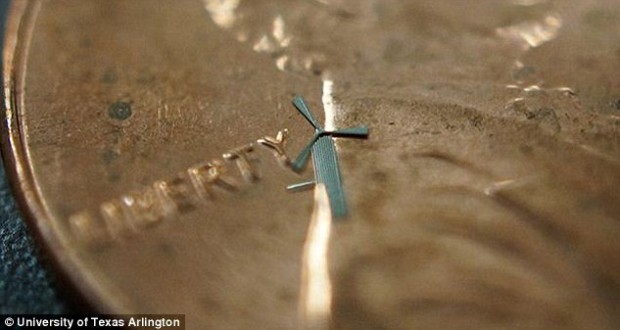By Victoria Woollaston
Forget hand-cranked chargers and solar-powered cases, the latest way to solve the ever-present problem of a dying phone battery is by using thin air.
Researchers from Texas have developed a miniscule ‘micro-windmill’ that is just 1.8mm wide and can transform wind energy into electricity.
The team behind the design claim hundreds of the nickel devices could be fitted to a phone case, for example, and users could charge their phone simply by waving it in the air.
Researchers from Texas have developed a miniscule ‘micro-windmill’ that is just 1.8mm wide, pictured here on a U.S. penny, and can transform wind energy into electricity. The team claim hundreds of the nickel devices could be fitted to a phone case, and users could charge their phone simply by waving it in the air
HOW DO MICRO-WINDMILLS WORK?
The windmills feature tiny blades that are spun in the
wind.
This in turn spins a shaft connected to a miniature generator that
can be connected to a phone’s battery, or other devices that require
energy.
Engineers claim that the nickel devices could be built into a sleeve,
or case, for a phone, tablet or other portable device.
When the device loses power the user could either wave it in the air to generate wind through the windmills, or place it in front of a window or fan.
According to the designers, hundreds of windmills could recharge a phone in ‘a few minutes.’
This case could also be placed out of a window, or in front of a fan,
to increase the amount of energy generated.
According to the researchers, this could then recharge a phone in a ‘few minutes.’
Each windmill is made of flexible nickel alloy components capable of taking strong winds without breaking.
They are so small that ten of them can fit onto a single grain of rice.
Professor J.C. Chiao from the university said: ‘The micro-windmills work well because the metal alloy is flexible and the design follows minimalism for functionality.
‘Imagine that they can be cheaply made on the surfaces of portable electronics, so you can place them on a sleeve for your smartphone.
Each windmill, close up pictured, is made of flexible nickel alloy components capable of taking strong winds without breaking. They are so small that ten of them can fit onto a single grain of rice. Taiwanese fabrication foundry WinMEMS Technologies owns exclusive rights to sell the concept
The windmills work in the same way as wind turbines, pictured. Blades are spun in the wind, which spins a shaft connected to a generator
‘When the phone is out of battery power, all you need to do is to put on the sleeve, wave the phone in the air for a few minutes and you can use the phone again.’
Professor Smitha Rao added: ‘The problem most designers have is that materials are too brittle.
‘With the nickel alloy, we don’t have that same issue. They’re very, very durable.’
Taiwanese fabrication foundry WinMEMS Technologies owns exclusive rights to sell the concept.
It has already started work on potential applications for the tiny windmills, although it is not known when they could be available to consumers.
As well as micro-windmills, the research team has developed gears, inductors, pop-up switches and grippers, which are as small as a fraction of the diameter of a human hair.
A statement from the university said: ‘These inventions are essential to build micro-robots that can be used as surgical tools, sensing machines to explore disaster zones or manufacturing tools to assemble micro-machines.’
![]()
 bakken.com The latest
Bakken North Dakota Shale News, local energy related community news, bakken
housing and energy related bakken jobs are all of the things that we will have
for you right here.
bakken.com The latest
Bakken North Dakota Shale News, local energy related community news, bakken
housing and energy related bakken jobs are all of the things that we will have
for you right here. 




